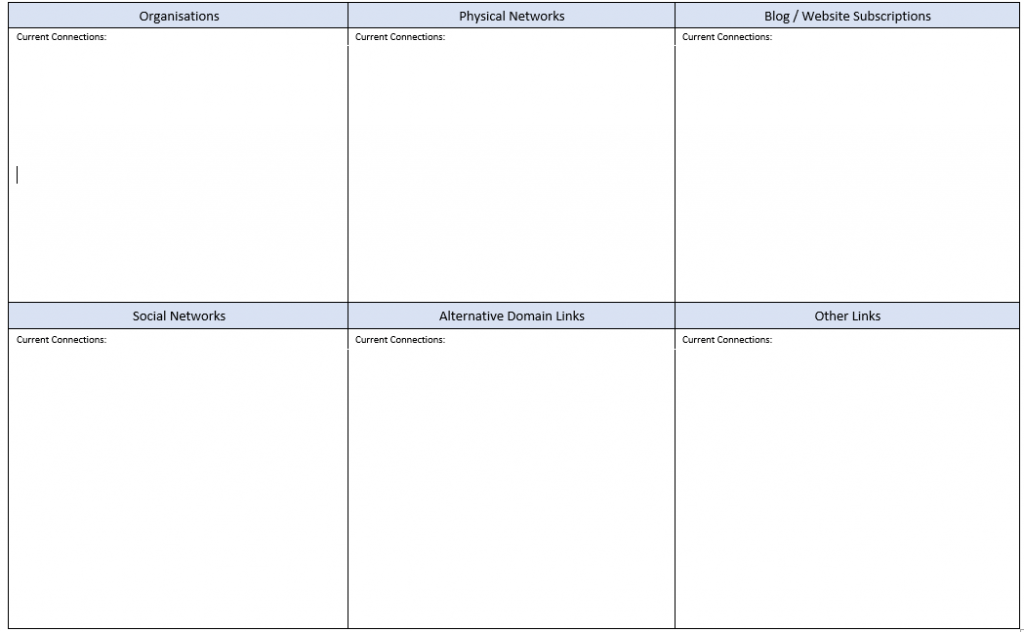Healthy Personal Learning Networks (PLN) enable individuals to acquire knowledge, perspective, support and opportunities through a broad yet balanced set of connections which they actively engage with and manage.
Personal learning networks are the accumulation of connections both physical and virtual that an individual has access to in order to increase knowledge, expertise and effectiveness. These connections can be inherited through the membership of an organisation or proactively created over time. Below are some of the possible sources of PLN connections:
Organisations with responsibility for governance, accreditation and professional development are a great source of connections for a PLN. Membership to these organisations may involve a subscription fee which often includes journal and event access. Examples would include: The Chartered College of Teaching, The Geographical Association, The Institute of Chartered Accountants.
The teams and groups that an individual belongs to both inside and outside their organisations are a key source of connections for their PLN. These connections are often aligned with role specialisms or responsibilities and involve face to face meetings and events. Examples would include: FNN, PAC, Subject Communities, DSL, Exam Officer networks.
The vast collection of amateur and professional websites and blogs found online are a dynamic source of information, resources and perspective. These rarely involve a financial commitment but subscription to these sites does enable individuals to receive regular updates. Examples would include: Teacherhead.com, Ofqual, Practicallyperfectpa.com
Online networks such as Twitter, LinkedIn, and Facebook provide opportunities to make a large and diverse network of people outside of an individual's organisation. These networks typically provide bite sized information and provoke thought and discussion. Social networks also facilitate the sharing of an individual's own thoughts and perspective.
Diversity is essential for organisational effectiveness and connections outside of the home domain (education, healthcare, business etc) enable individuals to explore different perspectives and approaches. There are often valuable lessons to be learned from the performance and learning of individuals from other sectors.
The connections within a PLN perform a wide range of functions and below are some of the benefits they bring:
PLN connections enable individuals to gain access to the most up to date thinking and knowledge from organisations and individuals.
The wealth of connections in a healthy PLN provide individuals with alternative viewpoints and the opportunity to wrestle with their established paradigms and beliefs.
Active engagement with a PLN often provides individuals with increased opportunities to share their ideas, contribute to resources and attend or lead events.
Physical and virtual connections within a PLN enable individuals to reach out for professional and personal support with temporary challenges or deeper issues.
PLNs are simple to create but need to be nurtured and managed in order for them to remain healthy and provide the maximum impact. Below are some characteristics of a healthy PLN.
Healthy Personal Learning Networks contain a broad range of connections. They are broad in terms of geography, stretching outside of the individual's organisation to include local, regional, national and international contacts. Healthy PLN connections are also broader than the organisational context and domain. Individuals recognise that there are lessons to learn from different contexts within their own domain but also from alternative sectors. The breadth of role coverage is another sign of a healthy PLN. Individuals actively seek out knowledge and expertise for all elements of their role in order to maximise their effectiveness.
Healthy Personal Learning Networks are balanced, leading to considered thoughts and choices. Individuals balance the number of connections which share their interests and beliefs with connections which challenge their thinking and add alternative perspectives. This diversity of thinking enables individuals to avoid blind spots and confirmation bias. Levels of engagement within a PLN are often connected to their level of impact and utility. In order to gain the maximum impact from a PLN the individual must balance the consumption of information with more active levels of engagement such as contribution or leadership.
Healthy Personal Learning Networks add value to the individual and provide a wealth of additional knowledge, resources and opportunities. Connections which add no value or negatively affect the individual should be removed. Individuals must proactively manage their network connections so they extract the most benefit and fill professional development gaps as they are uncovered.
The first step in a PLN review is to assess its contents and this can be achieved by making a list of the different connections that are regularly accessed. This can then be enhanced by attempting to categorise the different connections to identify areas of strength and network gaps. The image to the right is part of the PLN review document available to download below and facilitates this categorisation activity.

The second step of the review is to reflect on the balance of the PLN by assessing the following:
Locality – How wide does the PLN stretch geographically? (local, regional, national, international)
Domain – Do the PLN connections stretch into other organisational domains? (education, healthcare, business, government)
Elements – Are there connections for all elements of the individual's role? (operational, leadership, pastoral, personal management)
Challenge – Does the PLN contain connections that both support and challenge? (knowledge, opinions, contexts)
Engagement – What role does the individual typically take within the PLN? (consumer, participant, contributor or leader)


Personal Learning Networks are organic constructs that change dynamically and lose their effectiveness if left unmanaged. Below are two key strategies for developing your PLN:
PLN development comes from the proactive identification of network gaps and the search for suitable connections to satisfy those needs. PLNs that grow passively rarely reach high levels of effectiveness or harness the best opportunities available. The following are useful first steps:
The effectiveness of a PLN is directly related to the levels of engagement applied to it by its owner and that in turn is driven by the allocation of time and energy. Individuals must protect time to communicate with their network contacts, consume new information and take advantage of opportunities if they are to fully realise the power of their PLN.
